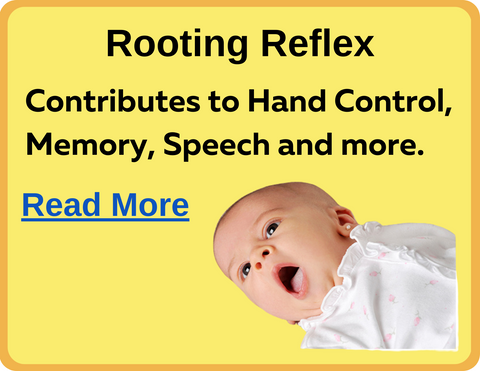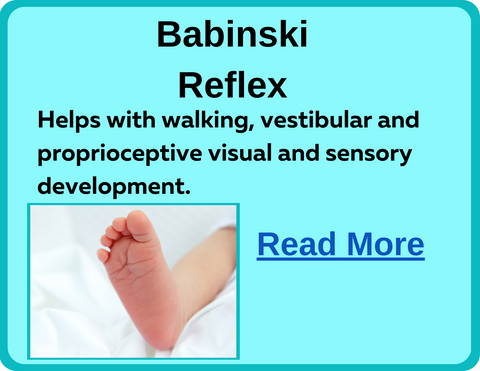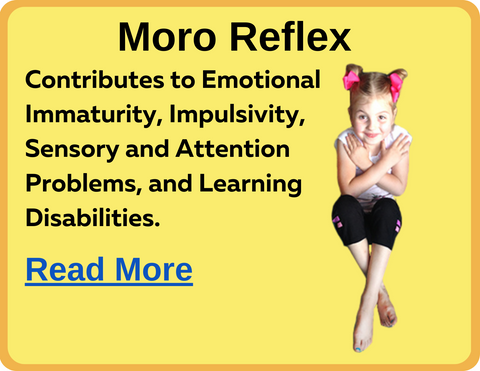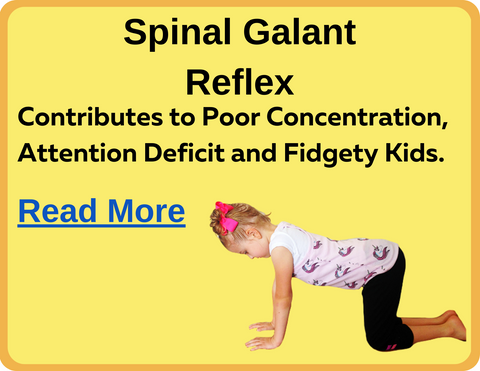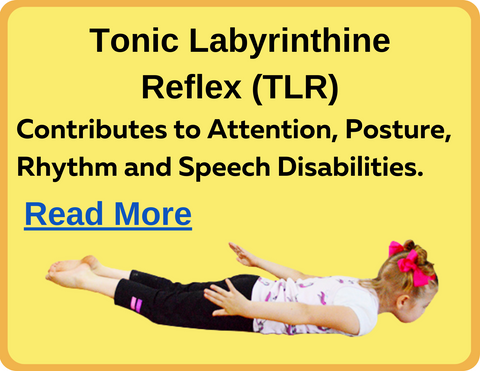News

Why Do Primitive Reflexes Return or Worsen
I have been asked why some primitive reflexes reappear after doing integration therapies. Also, why do some reflexes seem to get stronger before improving while doing the integration therapies? I...
Why Do Primitive Reflexes Return or Worsen
I have been asked why some primitive reflexes reappear after doing integration therapies. Also, why do some reflexes seem to get stronger before improving while doing the integration therapies? I...

Dysgraphia and Palmar Reflex
Exploring Dysgraphia What is dysgraphia? How is it different from dyslexia? While dyslexia is focused more on a child’s reading, dysgraphia is more centered around a child’s handwriting. Children...
Dysgraphia and Palmar Reflex
Exploring Dysgraphia What is dysgraphia? How is it different from dyslexia? While dyslexia is focused more on a child’s reading, dysgraphia is more centered around a child’s handwriting. Children...

Moro Reflex Test For Children of All Abilities
Testing for a retained Moro Reflex can be difficult with a very young or disabled person. This is an alternative test you can use to test for the Moro Reflex...
Moro Reflex Test For Children of All Abilities
Testing for a retained Moro Reflex can be difficult with a very young or disabled person. This is an alternative test you can use to test for the Moro Reflex...
Collapsible content
Client Handouts and Resources

It is important that your clients are educated on the importance of doing the Primitive Reflex assessments and exercises. It is, also, important that you, as a provider, have the tools you need. This handout will help your client understand why you want to test for PRs. It explains what Primitive Reflexes are, and the importance of integrating them. It is written in easy to understand language for them and their child.
Download our free Parent Handout. We recommend giving it to prospective clients with a copy of the Primitive Reflex Symptoms Checklist you received from us last week. This will help them see issues they are struggling with that may be helped by the exercises.
Tracking Charts
The most important pearls you can give your client about their Primitive Reflex Exercises, is how important consistency and frequency is. Your clients are busy too, so we know how those important send-home exercises are sometimes pushed to the back burner. Having some accountability helps, to make sure they get done. This in turn, contributes to their over all success with you.
Why Is My Child Acting Differently

When I started doing the Primitive Reflex and cognitive exercises with my daughter, Lyla, her behavior started to change. Problem was…it was not all for the good. We will talk about that in a minute, but first the wins….. From the time Lyla was a baby, she had been too hyper to be cuddled. She would wiggle and squirm away and could never relax like other babies. I knew then that she wasn’t typical. Lyla was 5 when I started brain stimulating exercises. At this time, my other girls would grab their blanky and come snuggle with me before bed time each night. Lyla had never joined. She was too busy roaring around the house acting like a T-rex, tearing the house apart and torturing our snuggle time.
Here is a download that charts Typical Childhood Development through the stages. Review the chart and understand your child’s mental abilities and growth as they advance through the developmental stages.
A win
One month into the exercises, Lyla came to me with her blanky and asked for snuggle time before bed…..my jaw dropped open…..’could this really be the exercises I’ve been doing?’ Well, it was! She sat there for 15 minutes with me that night. From that day on, Lyla has initiated snuggle time before bed, something I will never take for granted. It wasn’t the only gain. We started noticing her sitting through movies and meals better, noticing when she had hurt or offended someone and much more.
Now About the Negative Behavior
 We had noticed some other behavior too. When things didn’t go her way, she was more emotional. She cried easier, but a little less volatile. She still had some head spinning outbursts. But, I noticed that they were starting to be more emotional for her, more of a development of feelings that she didn’t know how to manage. It wasn’t just the usual lion tearing through the jungle. At this time I was still studying everything I could on brain stimulating types of exercises. I learned, as children go through exercises that mature neurological connections, such as Primitive Reflex or Sensory Motor balancing exercises, parts of their brain would go through the typical developmental stages that it should have, as the neurons connect and advance. Areas of Lyla’s brain would be maturing quickly through different developmental stages that typical children had already been through. The ‘terrible twos’ and ‘independent threes’ are actually part of normal development as the child learns they don’t always have to mirror their parent’s wants and emotions. They can have independent emotions and wants. Ya, I know every parent hates the ‘terrible twos’ and thinks their darling little toddler just turned into an unreasonable monster. But, it is actually a healthy part of development and won’t last forever with the right guidance and discipline. I remember thinking ‘But I know Lyla already went through the twos already. I almost didn’t make it. I feel like she never quite advanced past the terrible twos’. True!!!! And that is why it was so important to mature those neurological connections so that she could advance to a level of self control and self regulation that comes with maturity.
We had noticed some other behavior too. When things didn’t go her way, she was more emotional. She cried easier, but a little less volatile. She still had some head spinning outbursts. But, I noticed that they were starting to be more emotional for her, more of a development of feelings that she didn’t know how to manage. It wasn’t just the usual lion tearing through the jungle. At this time I was still studying everything I could on brain stimulating types of exercises. I learned, as children go through exercises that mature neurological connections, such as Primitive Reflex or Sensory Motor balancing exercises, parts of their brain would go through the typical developmental stages that it should have, as the neurons connect and advance. Areas of Lyla’s brain would be maturing quickly through different developmental stages that typical children had already been through. The ‘terrible twos’ and ‘independent threes’ are actually part of normal development as the child learns they don’t always have to mirror their parent’s wants and emotions. They can have independent emotions and wants. Ya, I know every parent hates the ‘terrible twos’ and thinks their darling little toddler just turned into an unreasonable monster. But, it is actually a healthy part of development and won’t last forever with the right guidance and discipline. I remember thinking ‘But I know Lyla already went through the twos already. I almost didn’t make it. I feel like she never quite advanced past the terrible twos’. True!!!! And that is why it was so important to mature those neurological connections so that she could advance to a level of self control and self regulation that comes with maturity.

Patience!
I’m going to end with reiterating ‘patience’. I had to exercise A LOT of patience as Lyla went through her changes. It happened very quickly and she was much better after about 6 weeks. But, patience was the key. If you lose your temper with them, they will see you as an out-of-control bully. They won’t feel like ‘someone in charge is setting a standard of behavior in the household’. They will see it as a bully-to-bully fight, with you winning and them losing. This will only fuel the ‘war’ inside them.
Keep a calm spirit and face as you deal with them in a rational manner, always remembering their developmental stage. They won’t make good judgement at first, nor every time. Their pre-frontal cortex is not yet developed. Show them an example of kindness, patience and forgiveness. Be quick to love them and accept the small gestures of repentance they show you. Give them choices on as many things as you can. They are starting to grow up and desire independence.
8 Primitive Reflexes Every Professional Should Know About


What Can Be Done?
If any of them remain past 12 months, they are called Retained Primitive Reflexes and they are a problem. There are simple exercises that can solve each one. This process is called Integrating Primitive Reflexes. Once they are integrated through these little exercises, many Learning Disabilities, Behavioral, Sensory Disorders, and health issues disappear or are greatly improved. You need to check for each of them, even if your child is not displaying the usual symptoms. If one remains unnoticed, it slows improvement in cognitive function. We will soon be adding information on Retained Babinski Reflex.
Symptoms when Primitive Reflexes Remain:
Because Primitive Reflexes start at the base of the brain. Functions that try to develop above them don’t wire properly. It can cause or contribute to:
Autism
Autism Spectrum Disorders
Asperger’s
Hemispheric Imbalance
Sensory Disorders
Hyper Activity
ADHD
Speech Disorders
Social Disorders
Asthma
Dyslexia
Dysgraphia
Dyscalculia
Immune Problems
Other Health Issues
Other Learning Disabilities
This is the first thing to check for. They can solve a multitude of problems. Other therapies or Brain Stimulation such as Hemispheric Integration Therapy, work best if Retained Primitive Reflexes are integrated or are being exercised first or at the same time.
How did this happen?
There are many children and adults that for one reason or another still have one or more Primitive Reflexes remaining. Some causes may include a traumatic birth, lack of “tummy time”, too much time laying in seaters or swings, induced labor, and traumatic C-Section birth. Most of the time, there is not a known reason.
Fear not. These are simple assessments and exercises that can be done 10 minutes per day for a few months. Then stimulate the other brain functions with these cognitive exercises and the Disabilities often go away or symptoms improve amazingly. Click on the individual pictures above to see the tests and exercises.




